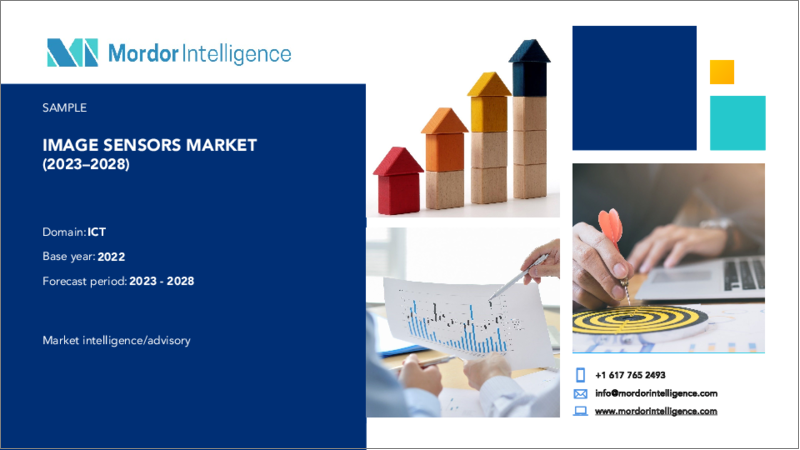|
|
市場調査レポート
商品コード
1197231
イメージセンサー市場- 成長、動向、予測(2023年~2028年)Image Sensors Market - Growth, Trends, and Forecasts (2023 - 2028) |
||||||
|
● お客様のご希望に応じて、既存データの加工や未掲載情報(例:国別セグメント)の追加などの対応が可能です。 詳細はお問い合わせください。 |
|||||||
| イメージセンサー市場- 成長、動向、予測(2023年~2028年) |
|
出版日: 2023年01月23日
発行: Mordor Intelligence
ページ情報: 英文 100 Pages
納期: 2~3営業日
|
- 全表示
- 概要
- 目次
イメージセンサーの世界市場は、予測期間中に9.2%のCAGRで推移すると予想されています。
イメージセンサーは、主に多くのイメージングデバイスやデジタルカメラで使用され、工業、メディア、医療、消費者向けアプリケーションでそのアプリケーションと画像の画質や保存を向上させる。輸送産業におけるビデオ監視の統合は、これらの地域で観察される重要な動向の1つです。例えば、カナダの公共交通機関のセキュリティを強化するため、同国では1日170万人の交通量があり、政府は統合カメラを備えた統合監視システムを配備しています。このことは、地域全体の市場をさらに押し上げると期待されています。
主なハイライト
- スマートフォン、セキュリティカメラ、ハイビジョンカメラ、カムコーダーの需要拡大により、イメージセンサー市場は予測期間中に高い成長率を記録すると予想されます。世界中のメーカーが、解像度、性能、ピクセルサイズなどの主要パラメータの向上に努めています。
- 民生機器では、スマートフォンが主要なカメラデバイスとなり、スチルカメラやデジタル一眼レフカメラを圧倒しています。スマートフォン分野での激しい競争は、メーカーに競争優位に立つためにより良いカメラを提供するよう促し、結果としてこの分野の技術革新に高い投資を行うことになりました。
- さらに、各社は高解像度・高機能なカメラをシステムで実現するために、スマートフォンのカメラの新機軸を模索してきました。例えば、サムスンの新しい5Gスマートフォンは、1億800万画素のイメージセンサーをベースにした背面広角カメラを含む5つのカメラで構成されており、これは小さなダイサイズに1億以上のピクセルに相当します。自撮り用の前面カメラには、世界最小の画素ピッチ0.7μmの48MPイメージセンサーを搭載しています。先日発表されたサムスンのGalaxy S10は、リアカメラが3つ、フロントカメラが1つの計4つのカメラを搭載しています。
- さらに、2022年2月、RealmeはソニーIMX766イメージセンサーを搭載した「9 Proシリーズ」を欧州全域で発売することを発表しました。このセンサーは、1/1.56インチの超大型センサーサイズ、大きなピクセルエリア、OISにより、スマートフォンが並外れた画像を撮影することを可能にします。さらに、このセンサーはF1.88の開口部を持ち、離れた場所でも鮮明な写真を撮影することができます。
- また、各社は調査した市場において、製品の革新性が評価されています。例えば、2022年2月、STMicroelectronicsは、スマートフォンなど向けの3Dイメージセンサー「VD55H1」を発表しました。このセンサーは、50万点以上の距離を測定することで、3次元表面のマッピングを可能にします。パターン照明の場合でも、センサーから最大5メートルの距離まで物体を検出することができます。
- COVID-19は、物や人の移動が制限され、サプライチェーンが大規模に混乱したため、市場にマイナスの影響を及ぼしました。世界経済が停滞しているため、必需品の配送が制限され、企業は収益目標を見直しました。
イメージセンサーの市場動向
スマートフォン向けCMOSイメージセンサーが大きく成長
- CMOSイメージセンサーは、複数のベンダーが開発を進めており、低価格カメラへの採用が進んでいます。同価格で高画質な電荷結合素子(CCD)センサーと比較されることが多いが、CMOSセンサーはカメラ設計を容易にする機能をオンチップで提供することにより、コンシューマー市場のローコストエンドで足場を固めつつあります。
- CMOSイメージセンサーは、民生用電子機器、車載用、セキュリティ、監視カメラなど、いずれも成長市場です。コンシューマーエレクトロニクス分野の台頭は、フロントカメラやリアカメラを内蔵したスマートフォンの普及によって拍車がかかっています。
- 車載用アプリケーションの拡大には、自動運転車の革新やADASによる促進要因の安全性の向上が拍車をかけています。また、CMOSイメージセンサーは薄暗い場所や暗い場所、光量の少ない場所など様々な環境下で動作するため、セキュリティ用途に使用され、セキュリティ・監視用CMOSイメージセンサー市場を強化しています。
- CMOSイメージセンサー業界は、ソニー株式会社(日本)が独占しています。895百万米ドル(1050億円)を投じて積層型CMOSイメージセンサーの生産能力を増強し、車載カメラ向けCMOSイメージセンサーを製品化するなど、さまざまな用途に向けたCMOSイメージセンサーの開発に取り組んでいます。
- さらに、2022年3月には、先進的なCMOSイメージセンサーを提供するSmartSens社が、初の50MP超高解像度1.0マイクロメートル画素サイズのイメージセンサー製品-SC550XSを発売しました。この新製品は、先進の22nm HKMG StackプロセスとSmartSens社のSmartClarity-2技術、SFCPixel技術、PixGain HDR技術など複数の独自技術を採用し、優れたイメージング性能を実現します。
- また、多くの世界の新興企業が、研究対象市場向けの製品イノベーションに注力しています。例えば、2022年2月、メタオプティクスレンズ技術のスタートアップであるMetalenzは、偏光センシングをコンシューマ機器やモバイル機器に組み込むことができ、スマートフォンのヘルスケア管理機能向上につながる新しい偏光技術を発表しました。
アジア太平洋地域が大幅な市場成長を実現
- 中国は、その経済成長と世界のエレクトロニクス市場シェアにより、著しい成長率を示しています。中国は、エレクトロニクスの主要な生産国と消費国のひとつです。中国国家統計局によると、コンピュータ、通信、その他の電子機器製造が増加しました。2021年に約6億8,285万トンの穀物生産量を生産しました。
- さらに、2021年12月-サムスン社は64MPのISOCELL GWBイメージセンサーを発売しました。中国のTecnoと提携して、新しいカメラセンサーを作成しました。サムスンはこのカメラセンサーを、色の正確さと明るさを向上させた写真を撮ることができる、最も「人間の目に近い」イメージセンサーとアピールしています。
- さらに、インドは世界でも有数の経済成長を遂げている国です。購買力の向上とソーシャルメディアの影響力の高まりが、電子製品市場を牽引することが期待されます。IBEFによると、2021年4月から12月までの電子財の輸出額は、前年の74億米ドルから49%増の110億米ドルに達しています。
- また、政府の取り組みにより、スマートシティが伸びています。スマートシティでは、モニタリング、監視、メンテナンスなど、さまざまな目的で電子ソリューションを取り入れることが予想されます。さらに、smartcities.gov.inによると、中央政府はこのような60のインテリジェントシティを開発するために9億7700万米ドルを割り当てています。
- さらに、韓国では、さまざまな監視システムが導入され、安全性が向上しています。韓国政府は安全のために、毎年、公共の場にCCTVカメラを設置しています。内政安全部(韓国)によると、2021年には、国内の公共の場所に新たに187,883台のCCTVが設置されました。監視カメラシステムの普及に伴い、イメージセンサーの需要も高まると予想されます。
- さらに、スマートフォン分野では、インドでは、サムスンが2022年3月にプレミアムスマートフォン「Galaxy S22」シリーズを発売しました。Galaxy S22シリーズには、Galaxy S22 Ultra、Galaxy S22+、Galaxy S22の3機種があります。Samsung Galaxy S22+は、開口部F1.8の50MPプライマリセンサー、開口部F2.2の12MP超広角センサー、開口部F2.4の10MP望遠レンズを背面に搭載したトリプルカメラシステムを搭載しています。
その他の特典
- エクセル形式の市場予測(ME)シート
- アナリストによる3ヶ月間のサポート
目次
第1章 イントロダクション
- 調査の前提条件と市場の定義
- 調査対象範囲
第2章 調査手法
第3章 エグゼクティブサマリー
第4章 マーケットインサイト
- 市場概要
- 産業バリューチェーン分析
- 産業の魅力度-ポーターのファイブフォース分析
- 供給企業の交渉力
- 消費者の交渉力
- 新規参入業者の脅威
- 競争企業間の敵対関係
- 代替品の脅威
- COVID-19が市場に与える影響に関する評価
第5章 市場力学
- 市場促進要因
- 自動車分野での需要増加
- 業界別アプリケーションにおけるジェスチャー認識/制御への需要
- 市場の課題
- CCD技術市場の縮小がOEMに与える課題
第6章 市場セグメンテーション
- タイプ別
- CMOS
- CCD
- エンドユーザー産業別
- コンシューマーエレクトロニクス
- ヘルスケア
- 産業用
- セキュリティ・監視
- 自動車・輸送機器
- 航空宇宙・防衛
- その他のエンドユーザー産業
- 地域別情報
- 北米
- 米国
- カナダ
- 欧州
- 英国
- ドイツ
- フランス
- その他の欧州地域
- アジア太平洋地域
- 中国
- インド
- 日本
- その他アジア太平洋地域
- 世界のその他の地域
- 北米
第7章 競合情勢
- 企業プロファイル
- Canon Inc.
- Ams AG
- Omnivision Technologies Inc.
- Panasonic Corporation
- Samsung Electronics Co. Ltd
- Sony Corporation
- STMicroelectronics NV
- Teledyne DALSA Inc.
- SK Hynix Inc.
- GalaxyCore Inc.
- Hamamatsu Photonics K.K.
第8章 投資分析
第9章 市場機会と将来動向
The Global Image Sensors Market is expected to register a CAGR of 9.2% over the forecast period. The image sensors are used primarily in many imaging devices and digital cameras to enhance the image's quality of picturization and storage with its applications in industrial, media, medical, and consumer applications. The integration of video surveillance in the transportation industry is one of the significant trends observed in these regions. For instance, to enhance security for the Canadian Public Transportation System, with the country having 1.7 million daily traffic, the government deployed a unified surveillance System with integrated cameras. This is further expected to surge the market across the regions.
Key Highlights
- Due to the growing demand for smartphones, security cameras, high-definition cameras, and camcorders, the image sensors market is expected to record a high growth rate during the forecast period. Manufacturers worldwide have been striving to improve major parameters, such as resolution, performance, and pixel size.
- In consumer electronics, the smartphone has become the primary camera device, dominating still cameras and DSLRs. Heavy competition in the smartphone segment has driven manufacturers to provide better cameras to have the edge over the competition, resulting in high investments in technology innovations in this field.
- Furthermore, the companies have been looking for new smartphone camera innovations to enable high-resolution, feature-rich cameras in systems. For example, Samsung's new 5G smartphone consists of five cameras, including a rear-facing, wide-angle camera based on a 108-megapixel image sensor; this equates to over 100 million pixels on a small die size. A front-facing camera for selfies incorporates a 48MP image sensor based on the world's smallest pixel pitch-0.7µm. The Galaxy S10 from Samsung, introduced recently, has four cameras, three rear cameras and one front camera.
- Moreover, in February 2022, Realme announced the launch of the 9 Pro Series across Europe, which features a Sony IMX766 image sensor. The sensor enables the smartphone to capture extraordinary images with a super large 1/1.56" sensor size, a large pixel area, and OIS. In addition, the sensor has an f/1.88 aperture that helps the user to capture clear pictures at a distance.
- Also, the companies are recognized for their product innovation in the studied market. For instance, in February 2022, STMicroelectronics introduced the VD55H1 3D image sensor for smartphones and other devices. The sensor enables the mapping of three-dimensional surfaces by measuring the distance to over half a million points. Objects can be detected up to five meters from the sensor, even with patterned illumination.
- COVID-19 has negatively impacted the market as the supply chain has experienced a massive disruption due to restrictions in the movement of goods and personnel. The lockdown in most global economies has resulted in deliveries limited to essentials and companies revising their revenue targets.
Image Sensors Market Trends
CMOS Image Sensor in Smartphone Witnesses a Significant Growth
- CMOS image sensor technology, which several vendors are ramping, is sustaining its vigorous move into low-cost camera designs. Although often disparagingly compared to charge-coupled device (CCD) sensors with superior image quality at the same price, CMOS sensors are establishing a foothold at the low-cost end of the consumer market by offering more functions on-chip that simplify camera design.
- Consumer electronics, automotive, security, and surveillance are all growing markets for CMOS image sensors. The rise of the consumer electronics sector has been spurred by the increasing popularity of smartphones with built-in front and rear cameras.
- The expansion of the automotive application has been spurred by the innovation of self-driving automobiles and advancements in driver safety with the help of ADAS. The capacity of CMOS image sensors to work in various lighting conditions, including dim light, darkness, and low light, has raised the use of CMOS image sensors for security applications, bolstering the CMOS image sensor market for security and surveillance.
- The CMOS image sensor industry is dominated by Sony Corporation (Japan). It has invested USD 895 million (105 billion JPY) to boost production capacity for stacked CMOS image sensors and commercialized the CMOS image sensor for automotive cameras as part of its efforts to develop CMOS image sensors for various applications.
- Furthermore, in March 2022, SmartSens, an advanced CMOS image sensor supplier, launched its first 50MP ultra-high-resolution 1.0μm pixel size image sensor product - SC550XS. The new product adopts the advanced 22nm HKMG Stack process and SmartSens' multiple proprietary technologies, including SmartClarity-2 technology, SFCPixel technology, and PixGain HDR technology, to enable excellent imaging performance.
- Many global start-ups also focus on product innovation for the studied market. For instance, in February 2022, Metalenz, a meta-optics lens technology start-up, unveiled a new polarization technology that enables polarization sensing to be integrated into consumer and mobile devices and leads to better healthcare management features on smartphones.
Asia Pacific to Witness Significant Market Growth
- China reflects a significant growth rate due to its growing economy and global electronics market share. China is one of the Significant electronics producers and consumers. According to the National Bureau of Statistics China, computer, communication, and other electronic equipment manufacturing increased. It produced around 682.85 million tons output of grain in 2021.
- Furthermore, in December 2021 - The company Samsung launched a 64 MP ISOCELL GWB image sensor. It created the new camera sensor in partnership with China's Tecno. Samsung has touted the camera sensor as the most "human eye-like" image sensor that can take photos with improved color accuracy and brightness.
- Moreover, India is one of the largest and fastest-growing economies in the world; the growing purchasing power and the rising influence of social media are expected to drive the market for electronic goods. According to IBEF, Exports of electronic goods grew by 49% to USD 11 billion from April to December 2021, compared to USD 7.4 billion the previous year.
- The country is also seeing growth in smart cities due to government initiatives. Smart cities are anticipated to incorporate electronic solutions for various purposes, such as monitoring, surveillance, maintenance, etc. Further, according to smartcities.gov.in, the central government allotted USD 977 million to develop 60 such intelligent cities.
- Further, South Korea has been made secure with various surveillance systems installed. The country's government has been installing CCTV cameras yearly, in public places, for safety purposes. According to the Ministry of the Interior and Safety (South Korea), in 2021, there were 187,883 new CCTVs installed in public places in the country. With the growing adoption of surveillance camera systems, the demand for image sensors is expected to rise.
- Moreover, in the smartphone sector, In India, Samsung launched its premium Galaxy S22 smartphone series in March 2022. The Galaxy S22 series includes three phones: the Galaxy S22 Ultra, Galaxy S22+, and Galaxy S22. The Samsung Galaxy S22+ has a triple camera system with a 50MP primary sensor with f/1.8 aperture, a 12MP ultra-wide sensor with f/2.2 aperture, and a 10MP telephoto lens with f/2.4 aperture on the back.
Image Sensors Market Competitor Analysis
The Image Sensors Market is fragmented in nature due to intense competitive rivalry. Levels of market penetration are not massive for any of the prevailing players in the market. Due to the high market growth rate, it is a significant investment opportunity; therefore, new entrants are entering the market. Key players are Canon Inc., Samsung Electronics Co. Ltd., Sony, Omnivision Technologies Inc., Omnivision Technologies Inc., etc.
- March 2022 - Sony Group Corporation ("Sony") announced the signing of a memorandum of agreement (the "Memorandum of Understanding") with Honda Motor Co., Ltd. ("Honda") for a strategic alliance in the field of mobility.
- January 2022 - OmniVision announced the next addition to its pioneering Nyxel near-infrared (NIR) technology family. The OX05B1S is the first 5 megapixels (MP) RGB-IR BSI global shutter sensor for in-cabin monitoring systems (IMS) in the automotive industry.
Additional Benefits:
- The market estimate (ME) sheet in Excel format
- 3 months of analyst support
TABLE OF CONTENTS
1 INTRODUCTION
- 1.1 Study Assumptions and Market Definition
- 1.2 Scope of the Study
2 RESEARCH METHODOLOGY
3 EXECUTIVE SUMMARY
4 MARKET INSIGHTS
- 4.1 Market Overview
- 4.2 Industry Value Chain Analysis
- 4.3 Industry Attractiveness - Porter's Five Forces Analysis
- 4.3.1 Bargaining Power of Suppliers
- 4.3.2 Bargaining Power of Consumers
- 4.3.3 Threat of New Entrants
- 4.3.4 Intensity of Competitive Rivalry
- 4.3.5 Threat of Substitutes
- 4.4 Assessment on the Impact of COVID-19 on the market
5 MARKET DYNAMICS
- 5.1 Market Drivers
- 5.1.1 Increasing Demand in Automotive Sector
- 5.1.2 Demand for Gesture Recognition/Control in Vertical Applications
- 5.2 Market Challenges
- 5.2.1 Diminishing CCD technology market would pose a challenge to OEMs
6 MARKET SEGMENTATION
- 6.1 By Type
- 6.1.1 CMOS
- 6.1.2 CCD
- 6.2 By End-user Industry
- 6.2.1 Consumer Electronics
- 6.2.2 Healthcare
- 6.2.3 Industrial
- 6.2.4 Security and Surveillance
- 6.2.5 Automotive and Transportation
- 6.2.6 Aerospace and Defense
- 6.2.7 Other End-user Industries
- 6.3 By Geography
- 6.3.1 North America
- 6.3.1.1 United States
- 6.3.1.2 Canada
- 6.3.2 Europe
- 6.3.2.1 United Kingdom
- 6.3.2.2 Germany
- 6.3.2.3 France
- 6.3.2.4 Rest of Europe
- 6.3.3 Asia Pacific
- 6.3.3.1 China
- 6.3.3.2 India
- 6.3.3.3 Japan
- 6.3.3.4 Rest of Asia Pacific
- 6.3.4 Rest of the World
- 6.3.1 North America
7 COMPETITIVE LANDSCAPE
- 7.1 Company Profiles*
- 7.1.1 Canon Inc.
- 7.1.2 Ams AG
- 7.1.3 Omnivision Technologies Inc.
- 7.1.4 Panasonic Corporation
- 7.1.5 Samsung Electronics Co. Ltd
- 7.1.6 Sony Corporation
- 7.1.7 STMicroelectronics NV
- 7.1.8 Teledyne DALSA Inc.
- 7.1.9 SK Hynix Inc.
- 7.1.10 GalaxyCore Inc.
- 7.1.11 Hamamatsu Photonics K.K.




